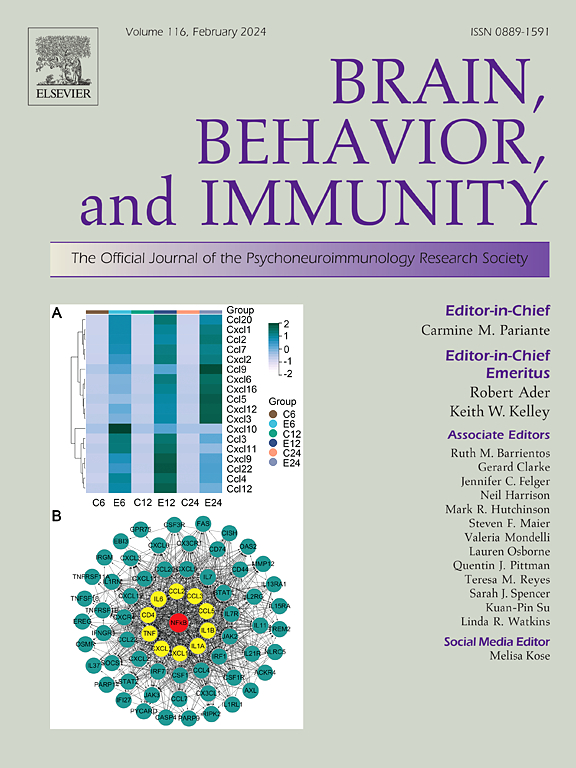A role for fibroblast and mural cell subsets in a nerve ligation model of neuropathic pain?
IF 7.6
2区 医学
Q1 IMMUNOLOGY
引用次数: 0
Abstract
Neuropathic pain is a particularly intractable type of chronic pain that can result from physical nerve damage due to surgery or entrapment. Here, we present data which suggest that a particular subclass of fibroblast and mural cells may be implicated in the sensory neuron dysfunction that is characteristic of this pain state.
In a mouse model of traumatic painful neuropathy, we used cell sorting, nerve tissue clearing and RNA sequencing to study stromal cells. With cell sorting (n = 4 mouse nerves) and tissue clearing (n = 5), we show that fibroblasts and mural cells positive for the platelet-derived growth factor receptor beta (Pdgfrb) gene are increased in number for at least two months post-nerve damage. Moreover, single cell RNA sequencing data (n = 4) from our own lab and those of three other laboratories reveal that Pdgfrb+ cells express high levels of known and putative pro-algesic mediators. Bulk sequencing of sorted Pdgfrb+ fibroblasts (n = 10) and Pdgfrb+/Cd146+ mural cells (n = 11) further indicate that many of these mediators are upregulated in neuropathy.
We go on to demonstrate that a human nerve pericyte line releases a selection of these pro-algesic mediators at protein level. Moreover, conditioned media from stimulated human pericytes induces intra-cellular changes in human induced pluripotent stem cell derived sensory neurons (n = 5 independent differentiations); these changes (phosphorylation of the transcription factor signal transducer and activator of transcription 3, STAT3) have been previously linked to sensory neuron activation.
In summary, our data indicate that stromal cell abnormalities should be considered when developing novel strategies to tackle neuropathic pain.

成纤维细胞和壁细胞亚群在神经性疼痛的神经结扎模型中的作用?
神经性疼痛是一种特别难治性的慢性疼痛,可由手术或压迫引起的物理神经损伤引起。在这里,我们提供的数据表明,成纤维细胞和壁细胞的一个特定亚类可能与这种疼痛状态特有的感觉神经元功能障碍有关。在小鼠创伤性疼痛性神经病模型中,我们采用细胞分选、神经组织清除和RNA测序等方法研究基质细胞。通过细胞分选(n = 4小鼠神经)和组织清除(n = 5),研究人员发现,在神经损伤后至少两个月,成纤维细胞和血小板衍生生长因子受体β (Pdgfrb)基因阳性的壁细胞数量增加。此外,来自我们自己的实验室和其他三个实验室的单细胞RNA测序数据(n = 4)显示,Pdgfrb+细胞表达高水平的已知和推定的促镇痛介质。对Pdgfrb+成纤维细胞(n = 10)和Pdgfrb+/Cd146+壁细胞(n = 11)的批量测序进一步表明,这些介质中的许多在神经病变中上调。我们继续证明人类神经周细胞系在蛋白质水平上释放这些促痛觉介质的选择。此外,来自受刺激的人周细胞的条件培养基诱导人诱导多能干细胞来源的感觉神经元的细胞内变化(n = 5个独立分化);这些变化(转录因子信号换能器和转录激活因子3,STAT3的磷酸化)先前被认为与感觉神经元的激活有关。总之,我们的数据表明,在制定治疗神经性疼痛的新策略时,应考虑间质细胞异常。
本文章由计算机程序翻译,如有差异,请以英文原文为准。
求助全文
约1分钟内获得全文
求助全文
来源期刊
CiteScore
29.60
自引率
2.00%
发文量
290
审稿时长
28 days
期刊介绍:
Established in 1987, Brain, Behavior, and Immunity proudly serves as the official journal of the Psychoneuroimmunology Research Society (PNIRS). This pioneering journal is dedicated to publishing peer-reviewed basic, experimental, and clinical studies that explore the intricate interactions among behavioral, neural, endocrine, and immune systems in both humans and animals.
As an international and interdisciplinary platform, Brain, Behavior, and Immunity focuses on original research spanning neuroscience, immunology, integrative physiology, behavioral biology, psychiatry, psychology, and clinical medicine. The journal is inclusive of research conducted at various levels, including molecular, cellular, social, and whole organism perspectives. With a commitment to efficiency, the journal facilitates online submission and review, ensuring timely publication of experimental results. Manuscripts typically undergo peer review and are returned to authors within 30 days of submission. It's worth noting that Brain, Behavior, and Immunity, published eight times a year, does not impose submission fees or page charges, fostering an open and accessible platform for scientific discourse.

 求助内容:
求助内容: 应助结果提醒方式:
应助结果提醒方式:


